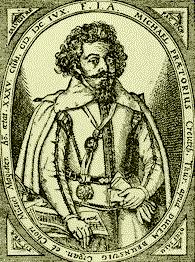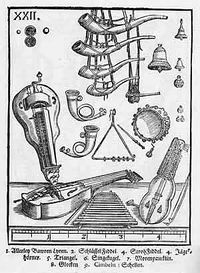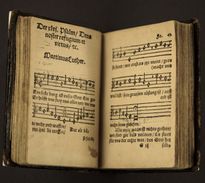Michael Praetorius

Michael Praetorius (Creuzburg, probably February 15, 1571 – Wolfenbüttel, February 15, 1621) was a German composer, organist, and writer about music. He was one of the most versatile composers of his age, being particularly significant in the development of musical forms based on Protestant hymns.
Contents |
Life
He was born Michael Schultze, the youngest son of a Lutheran pastor, in Creuzburg, Thuringia. After attending school in Torgau and Zerbst, he studied divinity and philosophy at the University of Frankfurt (Oder). After receiving his musical education, from 1587 he served as organist at the Marienkirche in Frankfurt. From 1592/3 he served at the court in Wolfenbüttel, under the employ of Henry Julius, Duke of Brunswick-Lüneburg. He served in the duke's State Orchestra Brunswick first as organist and later (from 1604) as Kapellmeister.
His first compositions appeared around 1602/3. Praetorius had started writing some of them when Regensburg was the parliamentary seat of the Holy Roman Empire. Their publication primarily reflects the care for music at the court of Gröningen. The motets of this collection were the first in Germany to make use of the new Italian performance practices; as a result, they established him as a proficient composer.
These "modern" pieces mark the end of his middle creative period. The nine parts of his Musae Sioniae (1605-10) as well as the 1611 published collections of liturgical music (masses, hymns, magnificats) follow the German Protestant chorale style. With these, at the behest of a circle of orthodox Lutherans, he followed around the Duchess Elizabeth, who ruled the duchy in the duke's absence. In place of popular music, one now expected religious music from Praetorius.
When the duke died in 1613 and was succeeded by Frederick Ulrich, Praetorius retained his employment. From 1613 he also worked at the court of John George I, Elector of Saxony at Dresden, where he was responsible for festive music on a grand scale. He was exposed to the latest Italian music, including the polychoral works of the Venetian School. His subsequent development of the form of the chorale concerto, particularly the polychoral variety, resulted directly from his familiarity with the music of such Venetians as Giovanni Gabrieli. The solo-voice, polychoral, and instrumental compositions Praetorius prepared for these events mark the high period of his artistic creativity. Until his death, Praetorius stayed at the court in Dresden, where he was declared Kapellmeister von Haus aus and worked alongside Heinrich Schütz.
Michael Praetorius is entombed in a vault beneath the organ of St Mary's Church in Wolfenbüttel, Germany.
Name
His family name in German appears in various forms including Schultze, Schulte, Schultheiss, Schulz and Schulteis. Praetorius is the Latinized form of the family name.
Works

Praetorius was a prolific composer and his compositions bear the influence of Italian composers as well as his younger contemporary Heinrich Schütz. His works include the nine volume Musae sioniae (1605–10), a collection of over a thousand (~1244) chorale and song arrangements; many other works for the Lutheran church; and Terpsichore (1612), a compendium of over 300 instrumental dances, which is both his most widely-known work, as well as his sole surviving secular work. His three volume treatise Syntagma Musicum, published between 1614–20 (I: Musicae artis analecta, II: De organographia, III: Termini musici), are detailed texts on contemporary musical practices and musical instruments, and are important documents in musicology, organology and the field of authentic performance.
See also
References
- Denis Arnold (editor), (1983), New Oxford Companion to Music, Oxford University Press. (Article by editor.)
- Jeffery T. Kite-Powell (translator and editor), (2004) Syntagma Musicum III: Termini musici (Wolfenbüttel, 1619) Oxford University Press.
- Stephan Perreau (1996). Liner notes to Praetorius: Dances from Terpsichore. Naxos 8.553865.
External links
- Free scores by Michael Praetorius in the Choral Public Domain Library (ChoralWiki)
- Free scores by Michael Praetorius in the Werner Icking Music Archive (WIMA)
- Free scores by Michael Praetorius in the International Music Score Library Project
- Michael Praetorius, biography on Goldberg, the Early Music Portal.
- Michael Pratorius - facsimiles in The Royal Library, Copenhagen
- Listen to free Vocal Evangelical Church Music by Michael Praetorius at "Early Vocal Music Map" from Umeå Akademiska Kör.
- More free scores
|
||||||||||||||||
